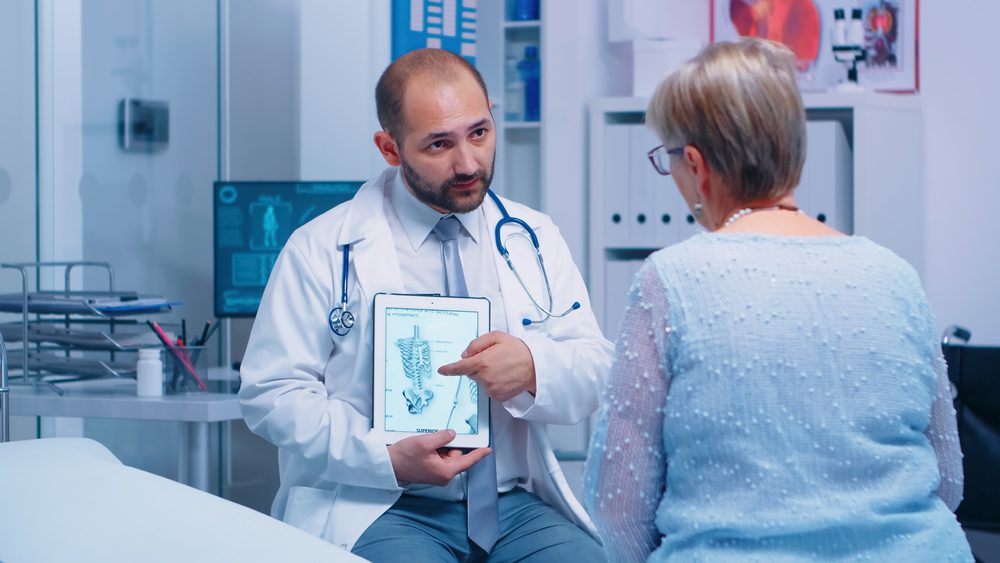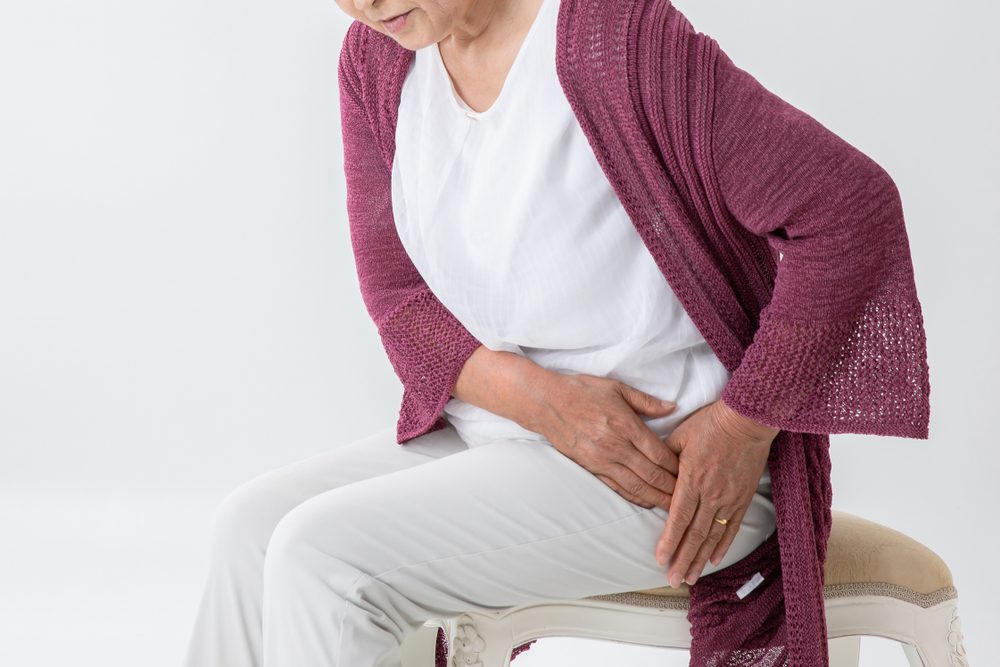Osteoporosis is causing bones to become weaker and brittle. In fact, they become so brittle, that an easy fall or even mild stresses like bending over or coughing might cause a serious fracture.
It’s a very serious disease. Fractures that are related to osteoporosis are most likely to appear in the hip, wrist, and especially spine. Our bones are living tissue that is prone to be broken down and replaced by new bones.
But in this case, osteoporosis appears when the creation of a new bone just can’t keep up with the loss of old bone. Osteoporosis can affect men and women simultaneously, no matter the race.
You might wonder why did I mention the race factor? Because studies show that white and Asian women, especially women who are at a more advanced age and past menopause, are the highest at risk.
However, there are medications, healthy diets, and weight-bearing exercises that can help prevent bone loss or strengthen those bones that are already weak.

Symptoms of the early-stage osteoporosis
Truth be told, it’s a rare thing to detect early signs of bone loss. Oftentimes, people don’t even realize they have weak bones until an accident occurs, such as a broken hip, wrist, or any other bone.
Even so, there are some signs and symptoms that might point toward potential bone loss, like:
- Receding gums – If your jaw is losing bone, your gums might recede. The best thing to do is ask your dentist to screen for bone loss in the jaw.
- Weaker grip strength – According to a study of postmenopausal women and overall bone mineral density, it has been discovered that low handgrip strength is directly linked to low bone mineral density. Plus, lower grip strength might increase the risk of falls.
- Weak and brittle fingernails – Did you know that nail strength can actually signal bone health? However, it’s important to take into consideration various factors that might affect your nails, like exposure to very hot or cold temperatures, nail polish that might be used regularly or acrylic nails, or submersion in water for a prolonged period of time.
Other than this, there aren’t many signs to which you might suspect osteoporosis, basically because it’s not the type of illness that shows many early symptoms. The best thing you can do is to have a talk with your doctor or a healthcare professional.
Signs of later-stage osteoporosis
Once the bone mass has initiated its deterioration process, you might start experiencing more obvious symptoms, like:
- Loss of height – If you wondered why you seem a bit shorter, it’s because of the compression fractures in your spine. Of all the symptoms related to osteoporosis, this one is the most noticeable of them all.
- Fracture from a fall – A fracture is one of the most common signs you might suffer from fragile bones. A fracture usually occurs from a fall, or from other minor movements, like stepping off a curb. There are some osteoporosis fractures that can be triggered by a strong cough or sneeze.
- Back or neck pain – Osteoporosis is at fault for causing compression fractures of the spine. Some of these fractures can be extremely painful, given that the collapsed vertebrae might pinch the nerves that radiate out from the spinal cord. The symptoms of pain can range from minor tenderness to debilitating pain.
- Stooped posture or fracture – The compression of your vertebrae might also cause a slight curving of the upper back. You probably know already that a stooped back is also known as kyphosis, which causes back and neck pain. Even more, it can have a negative effect on breathing, given the extra pressure on the airway and the limited expansion of your lungs.
Osteoporosis is the “silent thief” when you age
You have the best bone density in your early 20s. But the more you age, the more you can lose bone mass from a variety of factors. Osteoporosis has a so-called “little sister”, which is basically an earlier version of the disease, known as osteopenia, which signals an imbalance in the process of remodeling.
It basically means that there’s too much bone that breaks down and too little new bone that’s building back up. This results in brittle bones, which are prone to fracture.
Also, it’s worth mentioning that you need calcium to build stronger bones, but a low-calcium diet isn’t the only one to blame. There are also lesser-known causes of this disease.

Low Estrogen in Women
When it comes to osteoporosis, an estrogen deficiency is at fault in women, according to Paul Mystkowski, MD, an endocrinologist at Virginia Mason Medical Center in Seattle and Clinical Faculty Member of the University of Washington in Seattle.
After menopause, bone loss is accelerating, because older women have a quick drop in estrogen. In time, the risk of osteoporosis and fracture increases, given the fact that older women are losing more bone than they replace.
Younger women who don’t menstruate anymore, such as thin athletes or even girls who suffer from anorexia, might suffer from compromised bone density, at least according to the U.S. Surgeon General’s latest report called “Bone Health and Osteoporosis”.
Also, if you have both of your ovaries surgically removed, which is known as bilateral oophorectomy, you might also suffer from osteoporosis and low bone density.
There’s one study that shows how the surgery causes a 54% increase in hip, spine, and wrist fractures in those women who are currently in their postmenopausal state.
Low Testosterone in Men
You probably didn’t know this, but men need to have both good testosterone and estrogen levels for proper bone health. That is because men are converting testosterone into bone-preserving estrogen.
According to Dr. Mystkowski, “there’s a very clear consensus that when it comes to evaluating men with osteoporosis, you have to first consider a testosterone deficiency.”
When osteoporosis strikes in men with low testosterone levels, the condition is called hypogonadism. When the levels remain low, bone mass is likely to become lost over time, and it will eventually lead to weak bones that might become susceptible to fractures with minor trauma.
Other Hormone imbalances
The other hormones play a very important role in regulating your bone density, parathyroid hormone and growth hormone being included too.
They have a big input in orchestrating how well your bones are absorbing calcium, and when to build up or break down your bone. However, if there’s too much parathyroid hormone, known as hyperparathyroidism, it can lead to calcium loss in the urine at expense of your own bones.
Less calcium is automatically linked to weaker bones. The more you age, your body starts producing less growth hormone, which you’ll need to build stronger bones.
Lack of Calcium
As mentioned before, if you’re lacking calcium, your body won’t be able to rebuild new bones during the process of bone remodeling. Bones are the ones to hold two minerals – calcium and phosphorus.
Your body needs a constant level of calcium in your blood, given the fact that your organs (particularly your heart), muscles, and nerves, are highly dependent on your calcium levels.
So when these organs are demanding calcium, they will steal it from the mineral storehouse from your bones. In time, the more you deplete the mineral reservoir in your bone, the thinner and more brittle your bones will be.

Lack of Vitamin D
Calcium isn’t the only one that’s important for your bones. If you have low levels of Vitamin D, you can suffer from leaked bones and increased bone loss.
Active vitamin D, also known as calcitriol, will act more like a hormone than a vitamin, according to Mystkowkski. So among many other benefits, vitamin D is helping your body to absorb and use calcium as it should.
A Sedentary Lifestyle
Bones become weaker if you don’t put them to work. If you remember well about the early astronauts, they suffered from a rapid bone loss, because they were weightless up there in space.
So those people who are leading a sedentary life, or even suffer from conditions such as paralysis or muscular dystrophy, are more at risk of suffering from bone loss.
If you want to “remodel” your bones, there is something that can be done. Try working out with weight-bearing exercises, because you’re applying gentle stress on bones.
Thyroid Conditions
High levels of thyroid hormone have also been linked to an increase in bone loss. For most physicians, that’s always been a big concern, according to Mystkowski.
However, if you’re looking at the long-term bone densities of patients who are currently on high doses of thyroid pills, you won’t see a dramatic difference, and neither their fracture risk isn’t dramatically different.
Most doctors would agree on this: anyone who has high doses of thyroid hormone can have many benefits from getting regular exercise and taking enough calcium and vitamin D.
You might not believe it at first, but these lifestyle factors are essential for your overall fracture risk, alongside monitoring bone density with testing.
Smoking
Smokers have a higher risk of suffering from lower bone density and are more likely to fracture their bones than those who don’t smoke. There have been many studies conducted on smoking and how it relates to bone health, and they have discovered other dire effects, such as direct toxic effects of nicotine on bone cells, or the inability of our bodies to use estrogen, calcium, and vitamin D.
Also, those who are smoking are more prone to fractures, and they also suffer from a slower process of healing from fractures. So once again, smoking has proven to be extremely harmful to our bodies.
Medications
By taking some medications, such as long-term oral and injected corticosteroids, you can increase your risk of developing osteoporosis. When you use these meds for a longer period of time while also increasing the dose, corticosteroids are able to weaken your bones.
Thyroid medications, SSRIs, chemotherapy drugs, and many others can lead to this disease. Naturally, these medications might also be crucial in treating some serious conditions, so we don’t imply that you shouldn’t take them at all, especially if they have been prescribed to you by a doctor.
So you shouldn’t immediately stop your treatment, or even change the dose you’re taking, without consulting first with your healthcare adviser.
Medical Conditions
There are some medical conditions that are at fault for causing bone loss. So if you suffer from any of these conditions, you have a higher risk of developing osteoporosis.
It’s worth mentioning that there’s a type of osteoporosis caused by another medical condition, which is known as secondary osteoporosis. Such conditions include diabetes, inflammatory autoimmune diseases, thyroid conditions, or other malabsorption syndromes.
There are a couple of studies that show that type 1 diabetes might affect your bones when it comes to their normal density, and you might also suffer from low bone turnover and lower bone formation process.
Inflammatory autoimmune diseases, like rheumatoid arthritis or lupus, are serious conditions where the body basically attacks its own healthy tissues and unleashes inflammation all over your body.
Inflammatory conditions are known to increase the risk of bone turnover. People who suffer from these conditions are prescribed corticosteroids.
Hyperthyroidism and hyperparathyroidism are known to increase the risk of osteoporosis. Both these conditions affect your thyroid hormones. However, in the bone remodeling process, these hormones are playing a major role. Any kind of excess and deficiency might affect your bone mass.
Too Much Alcohol
Alcohol, just like smoking, has a very negative effect on bone health. First of all, it interferes with the balance of calcium and the absorption of vitamin D in the body.
Not to mention that heavy drinking can cause various hormone deficiencies in both women and men. By consuming alcohol in excess, osteoblasts might be killed, which are the ones that are responsible for bone-making cells.
Even more, alcohol abuse is known to affect balance and gait, which can only lead to falls, hence fractures, given that you might also have thinner bones and nerve damage.
If you enjoyed reading this article, we also recommend reading: 8 Things You Should Do Before Any Blood Test






